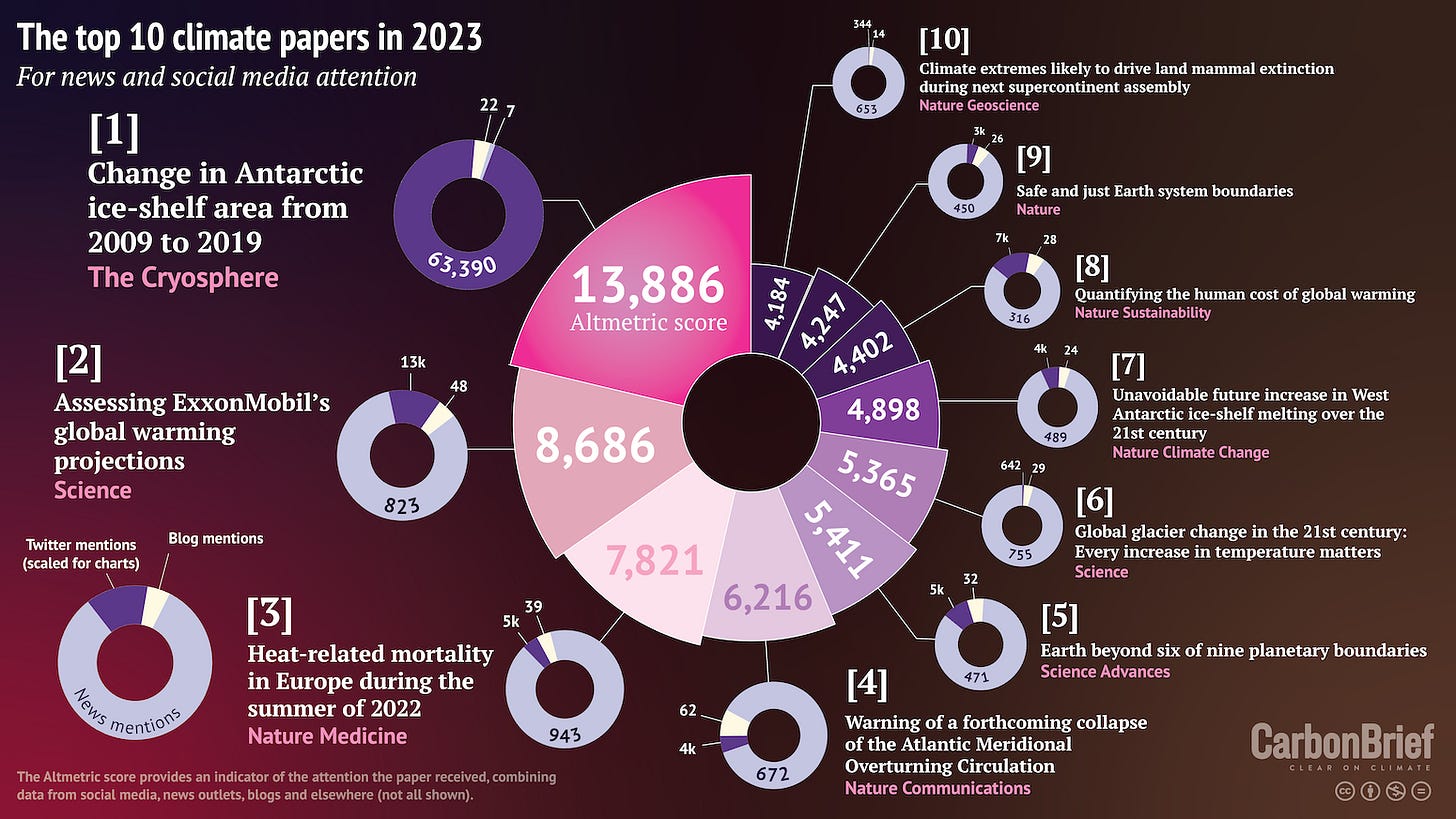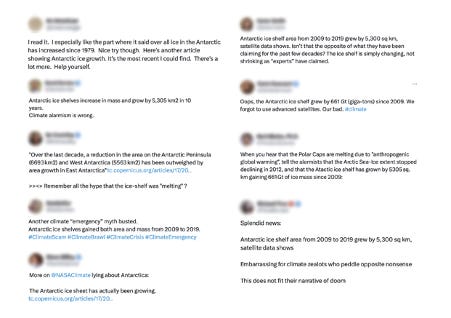TL;DR: In this week’s wrap of climate news,
and talk about how climate sceptics amplify research that confirms their own biases into the mainstream. They also discuss a survey about who are Aotearoa-NZ's climate sceptics and how they’re changing. We also discuss how they influenced the 2023 election result.Cathrine Dyer’s journalism on climate and the environment is available free to all paying and non-paying subscribers to The Kākā and the public. It is made possible by subscribers signing up to the paid tier to ensure this sort of public interest journalism is fully available in public to read, listen to and share.
How climate sceptics amplify their biases more widely
This week we are taking a look at a fascinating media analysis by Robert McSweeney and Ayesha Tandon over at Carbon Brief. Their analysis of the academic papers on climate that got the most media attention in 2023 reveals it was climate deniers driving the numbers on the most frequently-featured paper.
The Altmetric measure looks at how often academic papers appear in online news articles, blogs, and on social media.
Of the top 10 climate papers in the Carbon Brief analysis (shown in the diagram below), three addressed the cryosphere ie those parts of the earth’s surface featuring frozen water including sea, lake, and river ice; snowpacks, glaciers, ice caps, ice sheets and frozen ground. One further paper addressed the overlap between the cryosphere and the hydrosphere, specifically, the effect of melting ice on the Atlantic Meridional Overturning Circulation or AMOC.
Two papers addressed planetary and earth system boundaries. The remaining four discussed, in descending order: Exxon Mobil’s global warming projections; heat-related mortality in Europe during the summer of 2022; an attempt at quantifying the human cost of global climate change; and finally, one paper looked at land-mammal extinctions that would result from climate extremes during a super-continent convergence in the distant future.
But let’s look at the paper in the top spot.
It was called “Change in Antarctic ice shelf area from 2009 to 2019” and its score of 13,866 was substantially higher than any other climate paper in any previous review. The previous ‘high score’, from 2022, was 7,803.
The paper used satellite data to identify changes in the area of the ice shelves surrounding Antarctica, known as the ‘calving front’. In the decade following 2009, the ice shelf area increased by 5,300 square kilometres. This just goes to show that we live in a complex eco-system that responds to many forcings and feedbacks and occasionally produces counter-intuitive results that can temporarily mask long-term trends.
We now know that the Antarctic has followed-up with a precipitous and significant loss of ice shelf area in the early 2020’s, most spectacularly in 2023, fuelling suspicion that some kind of tipping point had occurred. In fact, the three other cryosphere-related papers in the review’s top ten contain warnings about such things as future loss of the West Antarctic ice sheet, collapse of the AMOC and sensitivity of glaciers to small temperature increases, all of which have meaningful implications for human societies.
But that was all lost on the deniers who saw one story that reinforced their pre-existing beliefs and loudly went to town with it, mostly as it turns out on twitter (ok, that bit is the opposite of shocking, you might even say banal). The paper only appeared in news articles a grand total of seven times.
... the paper’s high Altmetric score is principally a result of a huge number of mentions on Twitter – more than 63,000 posts from around 48,000 accounts. (Altmetric includes weightings in its scoring system, so news articles (with a weighting of eight) are deemed to have more impact than tweets (0.25).)
A closer look suggests that the paper has been widely quoted by the Twitter accounts of a number of prominent climate sceptics in an attempt to push back on concerns around climate change and the loss of Antarctic ice. These posts have then been widely retweeted by other accounts.
A selection of the climate-sceptic tweets relating to the Cryosphere paper. Source: Climate Brief
Carbon Brief spoke with study author Prof Anna Hogg from the University of Leeds.
To see the paper “being used as evidence to suggest that climate change isn’t happening” was a “real surprise”, says Hogg, because the paper “doesn’t make any such statement”.
Specifically, the gains the study identifies in ice-shelf area in east Antarctica do not detract from the risks of retreating ice shelves on other parts of the continent, says Hogg:
“The decrease in ice shelf area in west Antarctica is particularly important as this ice shelf area actively ‘buttresses’ the flow of ice from the ice sheet behind it, which through ice dynamic processes is one of the reasons why west Antarctica is contributing significantly to present-day sea level rise.”
What is striking about the analysis result is the extent to which the climate deniers were such dedicated and busy little bees. If only we could harness their startling productivity for good…
Most studies suggest the actual number of climate deniers is shrinking as the effects of climate change become increasingly difficult to ignore – but the remaining ones seem capable of having an outsized effect.
The noisiest 3.7%
Backing this up is a recent study by researchers Taciano Milfont, Ariana Athey and Chris Sibley exploring climate change beliefs and concerns in New Zealand.
They found that the largest group, 60.4% of those surveyed, was comprised of those with the highest level of belief in, and concern about, climate change. Meanwhile, those with the lowest levels of belief and concern made up the smallest group (3.7%). The study also found that over time, people are consistently moving toward higher levels of climate change belief and concern.
That small group labelled as ‘Climate Sceptics’ in the study are more likely to be “male, New Zealand European, religious and to endorse conservative and system-justifying ideologies that are expected to perpetuate a hierarchical social system”.
In other words, climate deniers are motivated by a desire to maintain current societal structures from which they benefit. So, it’s less about the science and more about power and culture. The paper goes on to say that:
Noticeably, a desire to dominate and be superior to others is the main predictor of membership in the climate change denial segment of the population, which fortunately represents a minority of the New Zealanders in our sample.
However, although representing a minority, the demographic and socio-psychological characteristics of individuals within the climate change denial profile are often overrepresented in powerful socio-economic positions in society, meaning that their denial can be extremely consequential in delaying action (taken from the paper’s conclusion).
That first bit will surprise absolutely nobody who has had the questionable pleaure of engaging with climate deniers online. Another problem, as discussed in a study (The New Climate Denial) that we featured in last week’s climate wrap, is that traditional climate deniers are shifting to different strategies to delay action on climate change.
A lot of the so-called ‘new denial’ focuses on energy systems and transitions, claiming that they won’t work, will be too expensive, or will cause living standards to decline.
These claims can and should be countered, but in the rush to deal with this cloaked denial, there is also some risk of enforcing allegiance to a particular paradigm of technological progress that features overly optimistic solutionism and green growth agendas.
‘Loopholes, weasel words, and vacuous generalisations’
In his latest blog, Sir Jonathon Porritt takes aim at those ““stubborn optimists” or “resolute climate solutionists” who still cannot accept just how fast things are changing around the world. Speaking about the final agreement coming out of COP28, he says:
It’s so full of loopholes, weasel words, and vacuous generalisations, let alone unlimited boosterism for all-but-useless technologies like Carbon Capture and Storage, as to fast track this Agreement instantly into the pantheon of toxic suicide notes.
Suffice to say that not all ‘climate solutions’ are equal – many are partial at best, and some are useless to the point of being a harmful distraction. The new denialists are not silly – they have moved into a space in which there is a lot more nuance and plenty of legitimate debate about the best path forward. For instance, some climate change solutions can contribute to the worsening of other planetary boundary problems such as biodiversity loss, demanding that we apply a wider lens to the way we define the problem-solution space.
We need to be alert to the way that commercial and fossil interests advocate and lobby to define that space in increasingly narrow and limited ways that just happen to coincide with their own profit-making potential. Stymieing the ‘new climate denialists’ while retaining a healthy level of scepticism about ‘solutionism’ is looking to be an increasingly complex and difficult task in a world of accelerating misinformation and disinformation.


















Share this post